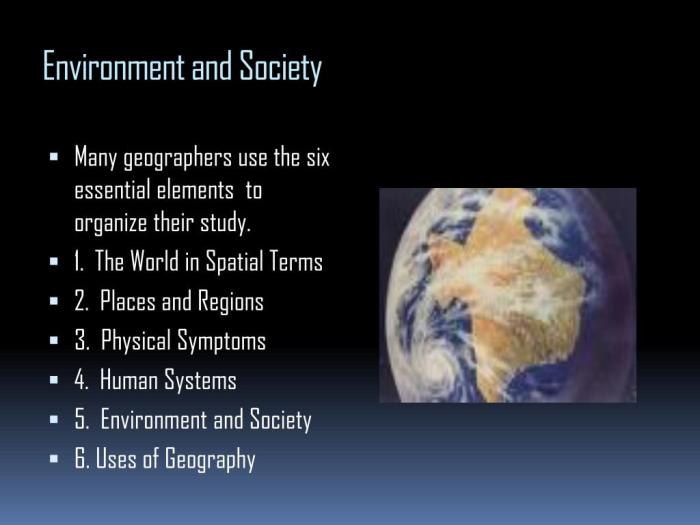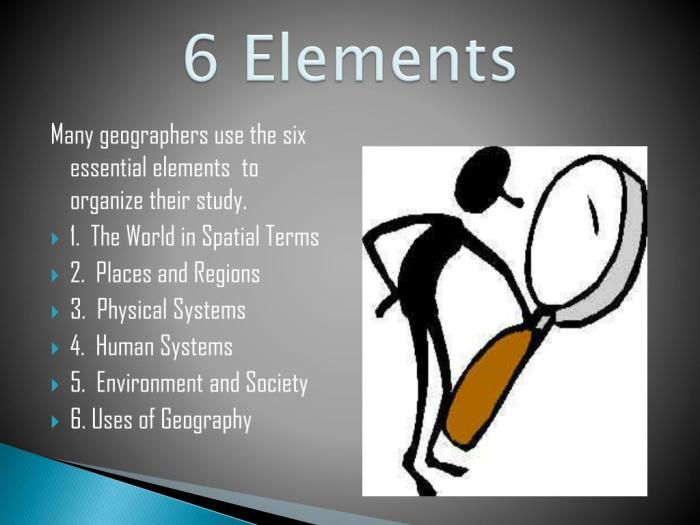The six essential elements of geography—location, place, human-environment interaction, movement, region, and time—form the cornerstone of geographic inquiry, providing a comprehensive framework for understanding the complexities of our planet and its inhabitants.
These elements are not merely abstract concepts but rather interconnected forces that shape the human experience, influence decision-making, and determine the distribution of resources and opportunities across the globe.
Location

Location is a fundamental concept in geography that describes the position of a place on the Earth’s surface. It can be expressed in absolute terms, using coordinates or addresses, or in relative terms, by describing its position in relation to other places.
Absolute location provides a precise and unique reference point for a place. It is typically expressed using latitude and longitude coordinates, which are based on the Earth’s spherical shape. Relative location, on the other hand, describes a place’s position in relation to other landmarks, such as cities, rivers, or mountains.
It is often used in everyday conversation and informal settings.
Location plays a significant role in shaping human activities. It influences factors such as climate, access to resources, and transportation networks. For example, places located near major rivers or trade routes have historically been centers of commerce and cultural exchange.
Similarly, places with favorable climates are often more densely populated and economically developed.
Role of Technology in Determining Location
Technological advancements have significantly impacted the way we determine and use location information. Global Positioning Systems (GPS) and Geographic Information Systems (GIS) have made it possible to accurately locate and map places on a global scale. These technologies have revolutionized fields such as navigation, land surveying, and urban planning.
- GPS uses a network of satellites to determine the position of a receiver on the Earth’s surface. It is widely used in navigation systems, smartphones, and other devices.
- GIS is a computer-based system that allows users to create, manage, and analyze spatial data. It is used in a variety of applications, including environmental modeling, land use planning, and public health.
These technologies have made it easier than ever to understand and utilize the concept of location, enabling us to make informed decisions and navigate the world around us more effectively.
Place

Place is a fundamental concept in geography that refers to a specific location on Earth’s surface. It is characterized by a unique set of physical and human attributes that distinguish it from other locations.
People perceive and experience place in various ways. Some may associate it with their home, a place of work, or a cherished vacation spot. Others may define it by its natural features, such as a mountain range or a river.
Place can also evoke emotions and memories, creating a sense of attachment or belonging.
Factors Shaping Place Identity
The identity of a place is shaped by a multitude of factors, including:
- Physical characteristics:The natural environment, such as topography, climate, and vegetation, can significantly influence the character of a place.
- Historical events:Significant events in the past can leave a lasting imprint on a place, shaping its culture, architecture, and social fabric.
- Cultural influences:The beliefs, values, and traditions of the people who inhabit a place contribute to its unique identity.
- Economic activities:The dominant industries and occupations in a place can shape its economic landscape and social structure.
- Political boundaries:The political borders that define a place can influence its laws, governance, and relationships with neighboring regions.
Human-Environment Interaction: Six Essential Elements Of Geography

The relationship between humans and their environment is a complex and dynamic one. Humans have always relied on the environment for their survival, but they have also had a significant impact on it. In recent centuries, human activities have accelerated the pace of environmental change, leading to a number of challenges, including climate change, pollution, and deforestation.
Impact of Human Activities on the Environment
Human activities have had a profound impact on the environment. The burning of fossil fuels has released greenhouse gases into the atmosphere, leading to climate change. Industrial activities have polluted the air and water, and deforestation has reduced the amount of habitat available for wildlife.
These changes have had a negative impact on human health, the economy, and the environment itself.
Strategies for Managing and Conserving the Environment
There are a number of strategies that can be used to manage and conserve the environment. These include:
- Reducing greenhouse gas emissions
- Improving energy efficiency
- Protecting forests
- Conserving water
- Reducing pollution
These strategies can help to mitigate the negative impacts of human activities on the environment and ensure a sustainable future for our planet.
Movement

Movement refers to the transfer of people, goods, and ideas across space and time. It plays a crucial role in shaping human-environment interactions, facilitating cultural exchange, and driving economic development.
The different types of movement include:
- Migration: The permanent or semi-permanent relocation of individuals or groups from one place to another.
- Commuting: The daily or regular movement of people between home and work or school.
- Trade: The exchange of goods and services between individuals, businesses, or countries.
- Tourism: The movement of people for recreational or leisure purposes.
- Diffusion: The spread of ideas, innovations, or technologies from one place to another.
The movement of people, goods, and ideas is influenced by various factors, including:
- Economic factors: Job opportunities, wage differentials, and trade agreements.
- Social factors: Family ties, cultural connections, and political instability.
- Environmental factors: Climate change, natural disasters, and resource availability.
- Technological factors: Transportation advancements, communication networks, and social media.
Movement has a significant impact on human and environmental interactions. It can lead to:
- Cultural exchange: The sharing of ideas, beliefs, and practices between different cultures.
- Economic development: The creation of new jobs, the expansion of markets, and the transfer of technology.
- Environmental degradation: The spread of invasive species, the depletion of natural resources, and the pollution of ecosystems.
Understanding the patterns and processes of movement is essential for addressing global challenges such as migration, urbanization, and climate change.
Region

A region is a geographic area that shares common characteristics, such as climate, culture, language, or history. Regions can be defined at various scales, from local to global.
There are two main types of regions: formal and functional. Formal regions are defined by a single, unifying characteristic, such as a particular language or religion. Functional regions are defined by the interaction of two or more factors, such as economic activity or transportation networks.
Factors Contributing to Regional Identity
The factors that contribute to regional identity can vary depending on the scale of the region. However, some common factors include:
- Geography: The physical features of a region, such as its climate, landforms, and water resources, can play a major role in shaping its identity.
- History: The historical events that have occurred in a region can also contribute to its identity. For example, a region that has been the site of a major battle or war may have a strong sense of patriotism or nationalism.
- Culture: The culture of a region includes its language, religion, art, and music. These cultural factors can help to create a sense of community and belonging among the people who live in a region.
- Economics: The economic activities that take place in a region can also contribute to its identity. For example, a region that is known for its manufacturing industry may have a strong sense of economic pride.
Role of Regions in Global and Local Affairs, Six essential elements of geography
Regions play an important role in both global and local affairs. At the global level, regions can cooperate to address common challenges, such as climate change or economic inequality. At the local level, regions can work together to improve the quality of life for their residents.
For example, a group of neighboring towns may form a regional planning commission to coordinate their land use and transportation policies.
Questions Often Asked
What is the significance of location in geography?
Location, both absolute and relative, plays a crucial role in shaping human activities and interactions. It influences factors such as climate, resource availability, and cultural exchange.
How does human-environment interaction impact the planet?
Human activities have a profound impact on the environment, both positive and negative. These interactions can lead to environmental degradation, climate change, and resource depletion, highlighting the need for sustainable practices.
What factors contribute to the identity of a place?
The identity of a place is shaped by a multitude of factors, including its physical characteristics, history, culture, and the experiences of its inhabitants. These factors collectively create a unique sense of place that distinguishes it from others.